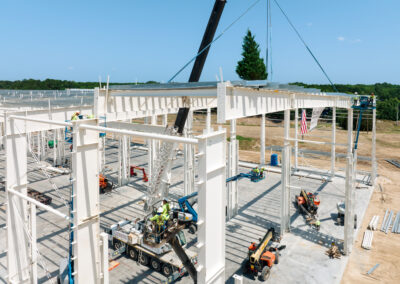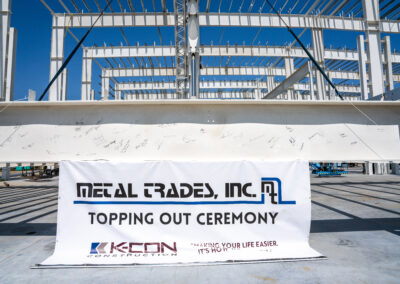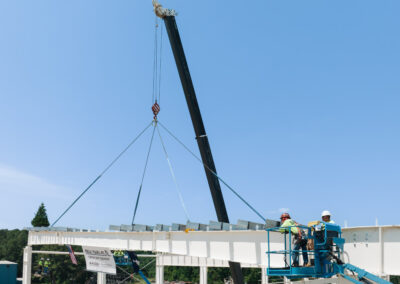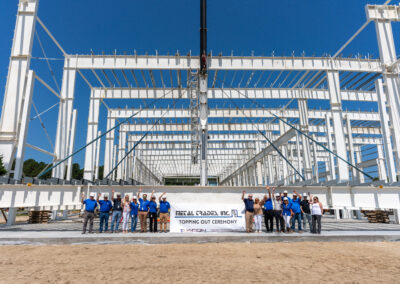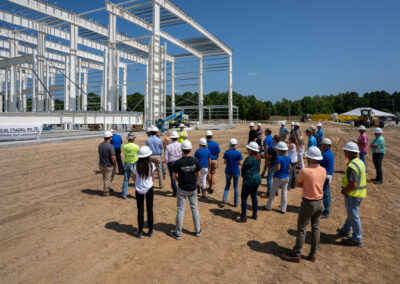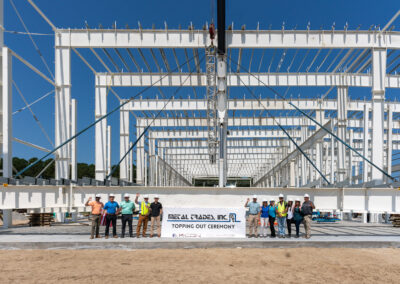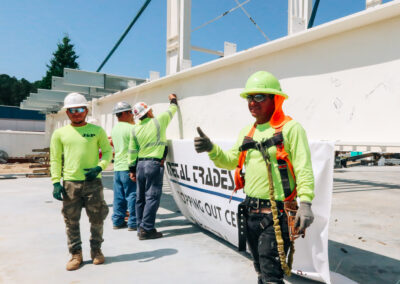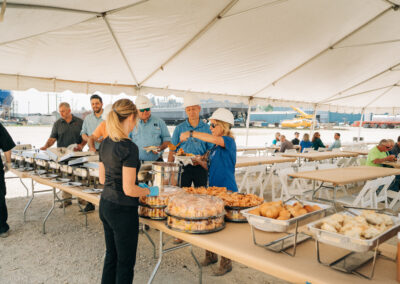On May 24, 2023, K-Con celebrated the Topping-Out Ceremony for Metal Trades, Inc. (MTI). The 80,000-square-foot Design-Build Pre-Engineered Fabrication Building honored the tradition by placing the final steel beam at the top of the structure on a bright, beautiful day in Meggett, SC. It was an honor to be joined by Metal Trades, partners, and our team to celebrate this important construction milestone.

What is a Topping-Out Ceremony?
In construction, few moments are as symbolic and significant as the topping-out ceremony. It’s a time-honored tradition that marks the culmination of a building’s structural phase. It’s a celebration of the hard work, dedication, and collaboration that goes into bringing architectural dreams to life.
The Origin of Topping Out Ceremonies: A Historical Perspective
While the exact origin of topping-out ceremonies remains elusive, evidence dates back to ancient civilizations across the globe. Topping-out ceremonies have been integral to construction projects for centuries, dating back to ancient Scandinavian and European traditions.
In Scandinavia, for instance, it was customary to hoist an evergreen tree, often a fir or spruce, to the apex of a new building. This ritual symbolized the harmonious union of nature and construction, with the tree serving as a gesture of gratitude for the resources used in the building. The Scandinavians believed the tree’s spirit would protect the future occupants and bestow good fortune on the structure.
Throughout history, similar practices emerged in other parts of the world. In ancient China, for example, builders would perform ceremonies involving placing a gilded ridgepole on the highest point of a structure, often accompanied by elaborate feasts and festivities.
Significance and Symbolism of Topping Out Ceremonies
Topping-out ceremonies are significant historically and in the modern construction industry. They are a symbolic milestone, marking the completion of the structural phase and the beginning of the finishing work. Here are some of the critical aspects of their significance:
-
- Team Spirit and Achievement: Topping out ceremonies celebrate teamwork and collaboration. Construction projects involve many skilled workers, from architects and engineers to carpenters and masons. The ceremony allows these individuals to come together, celebrate their collective achievements, and reflect on the challenges overcome.
- Ward Off Evil Spirits: The historical belief that spirits or deities were associated with the highest points of buildings has evolved into a symbolic act of warding off evil spirits and ensuring the building’s future safety and success.
- Blessing for Occupants: Topping out ceremonies often include blessings or well-wishes for the future occupants of the building. This tradition reflects a desire for the structure to be a place of prosperity, safety, and good fortune.
- Showcasing Skills: Construction workers take great pride in their craft, and topping out ceremonies serves as an occasion to showcase their skills and craftsmanship.
The Topping Out Ceremony: Modern Traditions and Customs
While the essence of topping out ceremonies remains consistent – celebrating the completion of a building’s structure – modern practices have evolved to reflect changing times and cultural variations. Here are some common customs associated with contemporary topping-out ceremonies:
-
- Placing the Final Beam or Element: In North America, a common tradition during topping-out ceremonies involves placing the final beam, often adorned with an American flag, at the highest point of the structure. This final beam is sometimes called the “topping out beam” or the “topping out piece.”
- Flags and Decorations: American flags are often prominently displayed during topping-out ceremonies to symbolize the structure’s completion. Companies will also place other decorations or banners to celebrate the occasion.
- Tree Topping: Although the original tradition of placing a tree or branch on top of the building has evolved, it persists in some regions. In modern topping-out ceremonies, putting an evergreen tree is a symbol of good fortune and growth.
- Speeches and Toasts: Key project stakeholders, such as architects, builders, and building owners, often deliver speeches during the ceremony. These speeches express gratitude to the construction workers and reflect on the project’s journey.
- Workers’ Recognition: Topping out ceremonies serve as a platform to recognize the hard work and dedication of the construction workers who contributed to the project’s success. It’s an opportunity to celebrate their craftsmanship and commitment.
- Feasting and Celebration: Traditional feasting and celebration are integral to many topping-out ceremonies in North America. Workers, project partners, and guests come together to share a meal, enjoy the accomplishment, and build stronger bonds.
Conclusion: A Celebration of Vision and Craftsmanship
Topping-out ceremonies are an enduring tradition that encapsulates the spirit of construction. They are a blend of history, symbolism, and celebration, and they remind us that building a structure is not just about bricks and mortar; it’s about the people who bring it to life. Topping-out ceremonies honor the architects’ visions, the engineers’ precision, and the workers’ dedication. They remind us of our ability to reach new heights, literally and symbolically, and create spaces where people can live, work, and dream.
In a constantly evolving world, these ceremonies bridge the gap between past and present, connecting us to the rich construction history while celebrating today’s innovative techniques and sustainable practices. They are a testament to the enduring human spirit, the desire to build, and the joy of achieving new heights. So, the next time you see a beam hoisted to the top of a skyscraper or a wreath placed on a new building, remember that it’s not just a construction milestone; it’s a celebration of human ingenuity and the power of collaboration.


